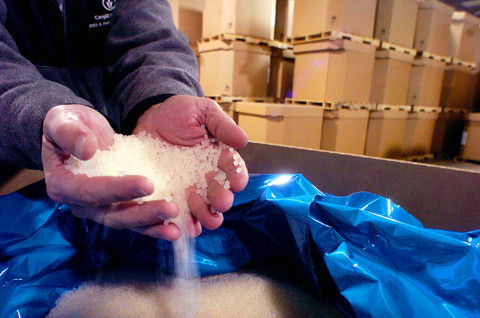A few years ago, scientists at Cargill Inc learned how to make rigid, transparent plastics from corn sugars. There was just one problem: They cost a lot more than the oil-based plastics they would replace.
But that was before the price of oil shot up and companies came under pressure from consumers and investors to find economically sound ways to adopt "green" packaging and other environmentally friendly products and processes. This year, Wal-Mart, Wild Oats Market, and a host of other retailers, as well as food suppliers like Del Monte and Newman's Own Organics, have all embraced corn-based packaging for fresh produce.
Sales at NatureWorks, the Cargill subsidiary that makes the plastic, grew 200 percent in the first half of this year over the period last year. "The early adopters were more influenced by environmental concerns than costs," said Kathleen Bader, chairman of NatureWorks. "But now we're competitive with petrochemicals, too."

PHOTO: NY TIMES NEWS SERVICE
Cargill is one of several companies profiting from the concerns -- of shareholders, communities, and consumers alike -- about global warming, leaking landfills, and other potential environmental hazards. Huge companies like General Electric and Chevron now have separate businesses to market what they are calling environment-friendly products.
And new companies and university projects appear each day. Cornell
University's College of Engineering, for one, expects to have a commercial process for using bacteria to recoup energy from wastewater treatment within three years.
"There are a lot of creative types looking for the next big thing," said Robert Sheppard, deputy director for corporate programs at Clean Air-Cool Planet, a nonprofit environmental education organization. "Well, these days, environment is it."
It is impossible to quantify the environmental industry. Many of the newer companies are privately held. And many "green" products -- more efficient power generators, say, or biodegradable plastics -- are parts of other industries.
But investors are clearly funneling ever more money into green technologies. Last year, the California Public Employees Retirement System, or Calpers, said it would invest US$200 million in what it called the "burgeoning environmental technology sector."
This year, 27 members of the Investor Network on Climate Risk promised to invest US$1 billion in companies with green products. "The environmental industry is about to take off, as more investors realize that they can reap returns from cleaner technologies," said Dan Bakal, director of electric power programs at Ceres, a coalition of investors and environmental organizations that runs the investor network.
cutting edge
Entrepreneurs say the change is palpable. Northern Biodiesel, a small company in Ontario, New York, recently got financing for a plant to turn cooking oils and agricultural waste into diesel fuel. "Banks used to dismiss me as a tree-hugger when I tried to borrow for an environmentally advantaged product," said Bob Bechtold, the
company's vice president.
In one sense, the current environmental boon is a replay of the 1970s, when regulations spawned a profitable industry to sell electrostatic precipitators, air scrubbers, and other air cleaning devices. New federal rules limiting diesel emissions are spurring sales now, too.
But this time, other powerful motivators are at play. The US did not sign the Kyoto treaty regulating greenhouse gases, but companies feel pressure to reduce gas emissions in order to comfortably do business in countries that did sign. Moreover, "people know that regulations will come here, too," said Judi Greenwald, director of innovative solutions at the Pew Center on Global Climate Change, a nonprofit research group.
Even without rules to force their hands, companies are responding to societal pressures to act in an environmentally sensitive manner. "Investors believe it is simply not acceptable to be environmentally irresponsible," said Abby Joseph Cohen, chief US investment strategist at Goldman Sachs, which just announced its own comprehensive environmental policy.
Others note that companies can no longer avoid the issue. "Shareholders are pressuring everyone to disclose what they are doing in the environmental arena," said Michael Johnston, executive vice president of Capital Group Cos, a money management firm.
The reasons are as much financial as moral, added Stanley Deutsch, a research analyst at Babson Capital Management. "Pension accounting, legal problems, and, these days, environmental problems, all can be claims on cash flow," he said.
In many cases, of course, sky-rocketing prices of oil and gas have given a boost to clean technologies. Procter and Gamble is substituting vegetable oils for petroleum derivatives in Tide detergent and Head and Shoulders shampoos, and rivals like Colgate and Kimberley Clark are
exploring alternative ingredients as well. Wal-Mart is looking at ways to burn used motor oil and cooking grease as fuel.
Even traditional energy companies are seeing sales of oil substitutes skyrocket. Eastman Gasification Services, a unit of Eastman Chemical Co, helps companies turn coal into a cleaner-burning fuel or raw material. David Denton, director of business development, says that sales are accelerating and that Eastman is now exploring ways to make chemicals from petroleum residues, the substances left when sulfur is removed from oil.
Air Products and Chemicals Inc, based in Allentown, Pennsylvania, has been selling "refinery hydrogen," which is used to remove sulfur from oil, for more than a decade. But now Air Products is building six plants, "as many as we've built at one time in our history," said Scott Sherman, the company's vice president for energy and process industries.
fuel hikes
Mark Gulley, an independent analyst who follows industrial gas companies, is not surprised. "High fuel prices have made refinery hydrogen a hot growth driver," he said.
GE, too, acknowledges that many products included in its much-touted "ecomagination" program were developed to boost energy efficiency. The products are either inherently green (like wind power), 10 percent greener than earlier products (more efficient jet engines), or meet government standards for energy efficiency (new power generators).
Still, the appetite for green energy is growing independently of high oil prices. Many new technologies "are tied less to the cost of energy than to the notion of making the world cleaner," said John Preston, a senior lecturer on entrepreneurship at the MIT Sloan School of Management.
In fact, much of the research into oil-free products predates the oil price spike. Since 2000, DuPont has been slowly replacing petrochemicals with ingredients like corn. Today, about 83 percent of its products use petrochemicals; it expects to drive that below 75 percent by 2010. "We are looking at our entire portfolio to see where we can make substitutions," said Thomas Connelly Jr., chief science and technology officer.
wal-mart to the rescue
Similarly, in 2000, Chevron started Chevron Energy Solutions to promote energy conservation products. "We don't see a correlation between the price of crude and our customers' interest in running green facilities," said James Davis, the unit's president. For example, Davis said that he counted as clients many universities whose electric bills had not increased, but who wanted to tout their "green campus" to prospective students, faculty, and donors.
The flipside -- avoiding negative publicity -- is an equally powerful motivator. CSI Leasing, which leases personal computers, was worried that discarded equipment would end up leaching chemicals into landfills. So last year, Executive Personal Computers, a CSI subsidiary that sells used computers, added a sideline business: collecting used computers from CSI and others, then stripping them into steel, plastic, and other components to sell as scrap.
Still, the biggest boost to green technologies is the goodwill bonus that environmental responsibility can confer. Wal-Mart, under fire for some labor practices and facing resistance to proposed new stores, is rolling out a program, already at 584 stores, to recycle shrink wraps, shopping bags, and other plastic items that once went to landfills.
Wal-Mart also has experimental stores in McKinney, Texas, and Aurora, Colorado, where it is testing the use of trees and grasses, particularly in parking lots, to absorb carbon dioxide emissions and tainted water; wind and solar energy to generate electricity; use of recycled materials for outdoor pavements; formaldehyde-free store flooring; and ways to recycle construction debris.

As I finally slid into the warm embrace of the hot, clifftop pool, it was a serene moment of reflection. The sound of the river reflected off the cave walls, the white of our camping lights reflected off the dark, shimmering surface of the water, and I reflected on how fortunate I was to be here. After all, the beautiful walk through narrow canyons that had brought us here had been inaccessible for five years — and will be again soon. The day had started at the Huisun Forest Area (惠蓀林場), at the end of Nantou County Route 80, north and east

Specialty sandwiches loaded with the contents of an entire charcuterie board, overflowing with sauces, creams and all manner of creative add-ons, is perhaps one of the biggest global food trends of this year. From London to New York, lines form down the block for mortadella, burrata, pistachio and more stuffed between slices of fresh sourdough, rye or focaccia. To try the trend in Taipei, Munchies Mafia is for sure the spot — could this be the best sandwich in town? Carlos from Spain and Sergio from Mexico opened this spot just seven months ago. The two met working in the

Exceptions to the rule are sometimes revealing. For a brief few years, there was an emerging ideological split between the Democratic Progressive Party (DPP) and Chinese Nationalist Party (KMT) that appeared to be pushing the DPP in a direction that would be considered more liberal, and the KMT more conservative. In the previous column, “The KMT-DPP’s bureaucrat-led developmental state” (Dec. 11, page 12), we examined how Taiwan’s democratic system developed, and how both the two main parties largely accepted a similar consensus on how Taiwan should be run domestically and did not split along the left-right lines more familiar in

A six-episode, behind-the-scenes Disney+ docuseries about Taylor Swift’s Eras Tour and Rian Johnson’s third Knives Out movie, Wake Up Dead Man, are some of the new television, films, music and games headed to a device near you. Also among the streaming offerings worth your time this week: Chip and Joanna Gaines take on a big job revamping a small home in the mountains of Colorado, video gamers can skateboard through hell in Sam Eng’s Skate Story and Rob Reiner gets the band back together for Spinal Tap II: The End Continues. MOVIES ■ Rian Johnson’s third Knives Out movie, Wake Up Dead Man